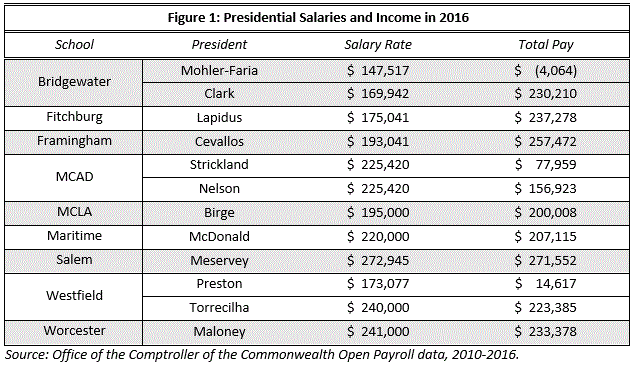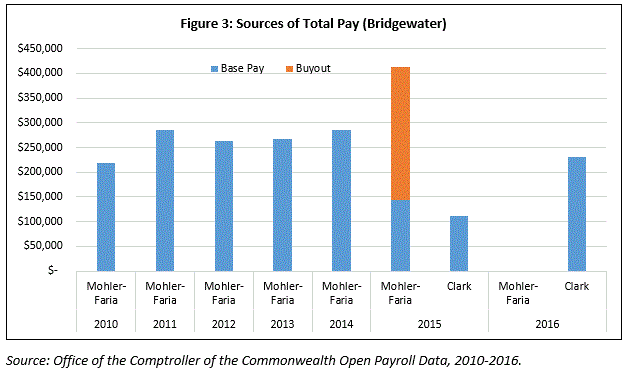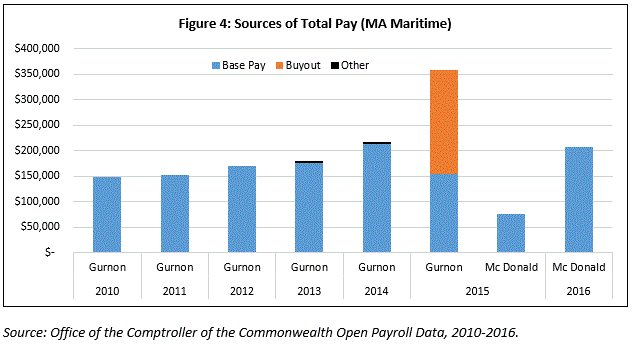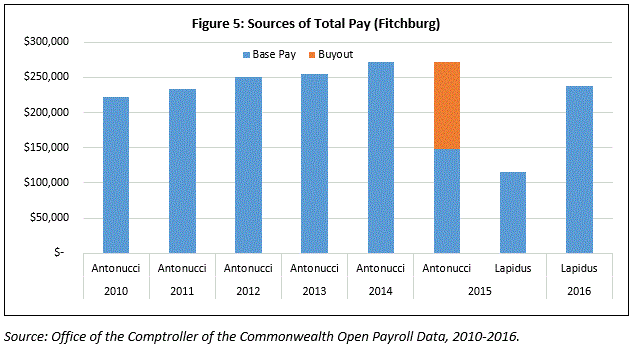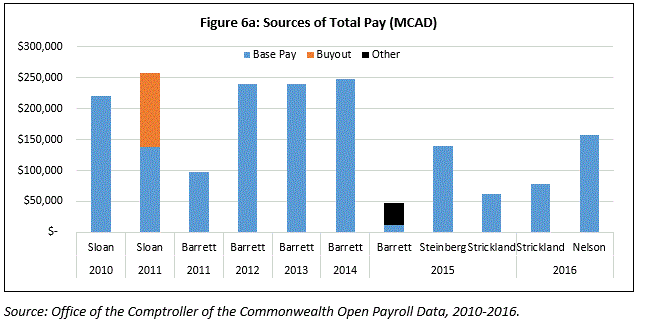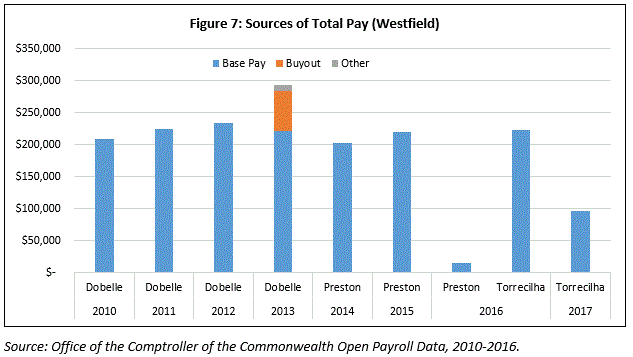The Crazy World of College Presidential Salaries Part 2: A Deeper Look
Part 1 of this blog series on MA state colleges and universities addressed presidents’ salaries since 2010. In general, although public funding for MA higher education institutions—specifically the state college and non-UMass university system—is decreasing, university presidents received annual raises, and sometimes very large raises and expensive buyouts. The picture is a bit murky, though, because of the various challenges faced each of the nine schools in the system. So how does each school measure up?
For context, Figure 1 presents an overview of how much the presidents of each college and university earned payroll in 2016. ‘Salary Rate’ refers to the annualized base rate at which the president was paid, while ‘Total Pay’ represents the net amount each received, including buyouts. In the cases where more than one president is listed, the universities had a change in leadership. This data can be found by using the MA Office of the Comptroller’s open payroll data tool.
As indicated, salary rates range from $147,517 to $272,945. Variances can be attributed to length of employment in the position, outside experience, and other factors. At first glance, some numbers stand out. For example, Bridgewater State paid President Clark $22,000 more than his predecessor President Mohler-Faria, who had served in the position for 13 years. Additionally, this chart indicates a negative value for former president Mohler-Faria, as he was required to return some of his earnings after he retired as a result of an investigation into his income. At Massachusetts College of Art and Design (MassArt), both individuals were acting presidents in 2016 at the same salary rate, and their total pay indicates neither served the full year. At Westfield State, President Preston was paid at a rate nearly $67,000 less than her successor.
The following case studies are designed to help readers understand some of the issues surrounding MA state college and university president salaries. A lot of the fluctuation in pay for university presidents comes from retirement or exit packages. Buyouts displayed below in Figure 2 often come in the form of one-time cash payouts, mostly comprised of unused sick or vacation days.
Bridgewater State University President Dana Mohler-Faria had the largest cash payout in Massachusetts since 2010, topping the list by almost $69,000. This post-retirement payout created controversy and has been extensively covered by the media after an official investigation and report by State Auditor Suzanne Bump. However, the other large payouts are evidence of a bigger issue among state employees. Governor Charlie Baker has attempted since May 2016 to pass legislation that would cap accrual of unused sick time for public employees, but the issue is controversial. Baker is trying to revive the proposal which would cap earnings to $1,000 of sick leave, and potentially save the state $3.5 million annually.
Bridgewater State University
Despite funding cuts, Mohler-Faria’s annual salary increased by $60,000 from 2010 to 2015. He ended his tenure as president making a total of $413,000 in 2015, which consisted partly of his base salary (see Figure 3, shown in blue) and a buyout of over $269,000 (shown in orange). This exit package was comprised of nearly $200,000 in unused sick time, in addition to a separate contract for $100,000 annually to serve as a consultant to the university, and an annual pension of $183,421 for a total cash payout of $269,984. In an investigation by the Boston Business Journal, Craig Douglas dug into the details of Mohler-Faria’s exit pay. First, Mohler-Faria was exempted from a cap on unused sick and vacation days because of his “professional employee” status, which is granted to higher-level state college and university executives. Most state employees are limited to cash in the full value of only 64 days. His large sick-day payout means that, according to the university, he took neither a sick day nor a vacation day during his 13 years at Bridgewater. He was paid for 900 unused days, which comes out to approximately 69 unused days per year.
Following an investigation by State Auditor Suzanne Bump, Mohler-Faria returned approximately $12,000 and agreed to consult for Bridgewater on a pro-bono basis.
In 2015 Frederick Clark assumed the office at a salary rate just barely above Mohler-Faria’s starting rate back in 2010. Clark’s pay only increased by about $4,000 in 2017. On the heels of the Mohler-Faria controversy, Clark has his weekly time sheet signed off on by the chair of the Board of Trustees, after the university blamed inconsistencies in time keeping on the lack of official record systems.
Massachusetts Maritime Academy
President Richard Gurnon of Massachusetts Maritime Academy received the second largest payout among MA state colleges and universities since 2010, with a cash payment of over $200,000 when he left the position in 2015. Maritime also had the largest overall growth in presidential salaries of the state colleges and universities since 2010 under Gurnon’s leadership, increasing almost 50 percent. As at Bridgewater, there was a transition between administrations in 2015, marked by a decrease in annual salary rate for the incoming president and a significant buyout for the exiting president. Gurnon saw an average 10.6 percent annual increase in salary from 2010 to 2015, the highest of any university president in this analysis. He received raises of 15 percent in 2011, 3 percent in 2012, 10 percent in 2013, and almost 17 percent in 2014. Including his buyout, his total 2015 earnings reached almost $358,000, 58 percent higher than his base rate (shown in Figure 6). This is interesting, considering that upon his retirement, the Boston Globe reported that his presidency was “at times controversial,” citing an instance where just months after he was appointed president, the board of trustees voted almost unanimously to fire him.
Francis McDonald succeeded Gurnon in 2015, and his starting salary was only slightly lower than Gurnon’s exiting rate. He received a 13 percent raise in 2016. A quick Google search reveals that Gurnon’s buyout has gone largely unreported by the media, despite occurring around the same time as the Bridgewater State investigation. The Boston Business Journal’s Bridgewater investigation mentions that Gurnon received a cash payout, but doesn’t reveal the amount or elaborate on the circumstances.
Fitchburg State University
Robert Antonucci served as Fitchburg State’s 10th president from 2003 until 2015. Since 2010, his salary rate rose by nearly $50,000, or about 4.5 percent annually. Upon his exit, Antonucci received the third largest buyout of these state colleges and universities, amounting to nearly $125,000 in 2015. The cash payout reportedly consisted of unused sick time and vacation days, yet was only marginally covered by media after the Bridgewater investigation. Because of this buyout, Antonucci’s total compensation actually rose in 2015, despite exiting in July (see Figure 5).
President Lapidus, who succeeded Antonucci in late 2015, earned a much lower salary rate than his predecessor during his first year at Fitchburg. Even with a slight raise in 2016, Lapidus’ salary is still more than $37,000 below Antonucci’s exiting salary, and remains lower than Antonucci’s 2011 salary rate.
Massachusetts College of Art and Design
MassArt has had five presidents since 2010. Each has had a different starting annual salary rate, with those that only stayed for a year or two starting much lower than the MCAD average. President Katherine Sloan received the fourth largest cash payout among MA state college and university presidents between 2010 and 2016.
Sloan had served since 1997, when her starting salary was much lower than is shown here. MassOpenBooks data goes back to 2004 and reveals that in addition to annual salary, Sloan received a $120,000 buyout when she left the job in 2011 (see Figure 6a), causing a spike in her total earnings that year.
Dawn Barrett took over in late 2011, and her starting salary rate (Figure 6b) was similar to Sloan’s. In 2015, Barrett‘s rate decreased by more than 46 percent from the previous year (see Figure 6b). This may be due to the fact that there was major turnover in MassArt leadership, as there were two other acting presidents in 2015. Her salary rate that year was nearly a third lower than that of her two successors, Kurt Steinberg and Kenneth Strickland, who also were paid as interim presidents in 2015.
Strickland stayed on in 2016, and current president David Nelson also served as acting president that year. Nelson’s annual rate in 2016 (Figure 6b) was about $60,000 higher than Strickland’s, and was the highest of any the presidents from 2010 to 2016. Strickland and Steinberg have returned to their previous positions at MassArt.
The MassArt case is interesting because its high executive turnover seems to correlate with fluctuations in presidential salary rates and total pay.
Westfield State University
Another interesting case comes from the turnover at Westfield State University. President Evan Dobelle saw a 5.2 percent annual raise during his time as university president. However his 2013 exit also resulted in more than $70,000 in buyouts and other pay sources (see Figure 7), which resulted in Dobelle ranking fifth in terms of the largest MA state college and university buyouts since 2010.
Incoming president Elizabeth Preston took over in 2014 with a starting salary rate that was comparable to Dobelle’s 2010 figure. She received a slight raise in 2015, but she left after having earned just $14,617 in 2016. Her successor, Ramon Torrecilha, received a starting salary higher than either Preston or Dobelle before her—starting at $240,000 in 2016 and receiving a small raise in 2017.
Salem State University
Unique among state colleges and universities, Salem State University had only one president, Patricia Meservey, since 2010. Meservey just retired at the end of this academic year. The University has elected John D. Keenan, as its 14th president, and he will begin in August 2017. Meservey’s salary rate has increased annually by about 4.4 percent, or $64,000 over the period. However, her 2015 total earnings are more than $10,000 above her annual rate, despite not having received any other forms of earnings, such as buyouts, according to data from the Comptroller.
MA state colleges and universities all have unique stories of development, leadership and finance. Some of these institutions pay more for their presidents than others, and some give very large cash payouts to departing leaders. While certainly college presidents should be incentivized to lead their school toward bigger and better things, their salaries are taxpayer funded, and they should be held accountable as such. While some proposals may allow for extravagant payouts to be trimmed in the future, to this day MA taxpayers are spending big sums on public higher education—and so are students and their families.
Stay tuned for Part 3 of this series, which will look at academic outcomes and tuition increases in MA’s state college and university system.


